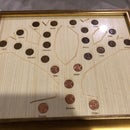Introduction: Dog Food Bowl Stand - Plywood and 3d Printing
Some senior or large dogs benefit from eating off of a raised platform. We have two older dogs with joint issues and a Great Pyrenees who is very tall. Our vet recommended raising their food bowls. Please consult your vet before switching to a raised feeding bowl.
I knew that I would prefer to make something as opposed to buying it, and did not want to expend too many resources. I had nice plywood at work and access to 3d printers so I decided to try and make a simple stand. (And also enter the plywood contest)
The finished product will work for our needs. The stand can be easily taken apart to store. It can be made more stable by using thicker brackets and by bolting them in or using glue.
Step 1: Materials and Resources
Materials and other resources
- Plywood, long enough to make three pieces the right height. (for me, the current build model is 10 inches off the ground for one of our shorter dogs)
- CAD software (I used Solidworks because I have access to it but there are many free or cheaper options such as Fusion 360, tinkercad, etc.)
- 3d printer ( the printer I used was a Monoprice Voxel which is a very affordable printer) and filament (I used PLA)
- Saw for cutting plywood to length
Step 2: Step 2 - Make Bracket in CAD
Design the bracket in CAD. A couple of things I discovered or thought about while making this - the angle of this bracket is 60 degree. When I make the taller one for the taller dog, I will increase the angle so not to have the legs spread out so far. The angle can be adjusted for the desired height and width. Also, I flipped the cut outs for two brackets because you have to! I learned that the hard way, you CAN NOT print four of the same pieces, they will not be oriented correctly.
I've attached one of (I think) the STL files for printing.
Attachments
Step 3: Step 3 - Print Parts
I will not be going into detail 3d printing. The Voxel is as simple as it can be and almost fool proof for its price point.
I did print out a couple different versions.
Step 4: Step 4 - Cut Wood
The only part of this process is figuring out how long to cut your legs. Knowing a little trigonometry and the pythagorean theorem comes in handy as we are dealing with a triangle. For my example, a 12 inch leg produces a top tray height of 10 inches. This will vary depending on the angle of the printed bracket. You can adjust the angle or length of the legs to get more or less height.
The cutting was done with a jigsaw but any wood cutting method would work.
Step 5: Step 5 - Put It Together
The wood just slips into the brackets. I will be adding bolts or screws to make them more stable but they work fine without anything.
That's it, you are done with your raised feeding platform!






